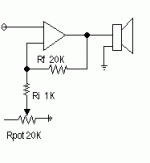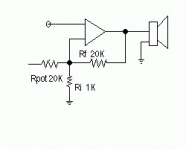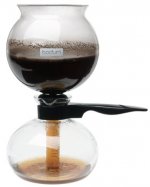I see almost everyone in most cases does volume control by putting a pot inline with R(in) or replaceing it completely. But this seems to cause problems for some because that changes the input resistance.
So I have a question. Can you use a pot to adjust the gain by increaseing Ri. Since gain is determined by Rf/Ri right? Rf=20K and Ri=1K equals a gain of 20? So if you added 9K or resistance to Ri the gain is now 2 right? But the input resistance stays at 47K or whatever you set it at. Plus less stuff in the input path!!!
Does this cause any problems such as oscilating or other stability problems? Plus wouldn't the noise be lower, the less gain you have?
Attached is a drawning of what I mean. Hope I'm not irratatiing you with all my crazy ideas!
I left Ri in there as 1K, that way at zero resistance on the pot you still have some resistance...sorta as a safety thing. And I used a 20K pot purely out of ease of numbers, I don't think there are 20K pots.
So I have a question. Can you use a pot to adjust the gain by increaseing Ri. Since gain is determined by Rf/Ri right? Rf=20K and Ri=1K equals a gain of 20? So if you added 9K or resistance to Ri the gain is now 2 right? But the input resistance stays at 47K or whatever you set it at. Plus less stuff in the input path!!!
Does this cause any problems such as oscilating or other stability problems? Plus wouldn't the noise be lower, the less gain you have?
Attached is a drawning of what I mean. Hope I'm not irratatiing you with all my crazy ideas!

I left Ri in there as 1K, that way at zero resistance on the pot you still have some resistance...sorta as a safety thing. And I used a 20K pot purely out of ease of numbers, I don't think there are 20K pots.
Attachments
there is nothing wrong with doing it that way but you will need a resistor from the pot to ground or else with the wiper advanced all the way your source will see a short
misread it...your input is not on the pot....your feed back will change for sure
misread it...your input is not on the pot....your feed back will change for sure

volume adjustment
By adding a pot there, you change the open loop gain of the circuit when adjusting. When you change the gain, you will also be changing the phase response. If amp is not unit gain stable, it will oscillate. As you change gain, the offset can vary. Running even short wires to the pot will add some capacitance.
That why you don't see pot in the circuit there.
By adding a pot there, you change the open loop gain of the circuit when adjusting. When you change the gain, you will also be changing the phase response. If amp is not unit gain stable, it will oscillate. As you change gain, the offset can vary. Running even short wires to the pot will add some capacitance.
That why you don't see pot in the circuit there.
Hi,
Nice bit of lateral thinking, but unfortunately there may be stability problems.
The chip amp is just an op-amp. These are stable for a particular range of gain. If you reduce the gain too much it will probably hoot.
You also cannot reduce the signal to zero.
Cheers,
Nice bit of lateral thinking, but unfortunately there may be stability problems.
The chip amp is just an op-amp. These are stable for a particular range of gain. If you reduce the gain too much it will probably hoot.
You also cannot reduce the signal to zero.
Cheers,
Re: volume adjustment
how do you change the open loop gain? close loop gain? maybe but open loop gain?
I think it could work (and likely works) as a lot of power amps are unity stable - all bridgeable amps are unity stable for example. It is just I cannot see any benefit for doing this.
jewilson said:By adding a pot there, you change the open loop gain of the circuit when adjusting. [/B]
how do you change the open loop gain? close loop gain? maybe but open loop gain?
I think it could work (and likely works) as a lot of power amps are unity stable - all bridgeable amps are unity stable for example. It is just I cannot see any benefit for doing this.
The reason I was thinking this was because it would keep the input impedence at a constant, plus you wouldn't have a cheap potetiometer in the signal path. Although I admit my knowledge is low, but someone had already taken a name indicating that ( 😉 )
I added that 1K resistor that way even if you put the pot all the way to no resistance it still would have 1K. Actaully thus setting the maximum gain level, because turning the pot would lower level...just backwards compared to normal.
But I guess as long as you put the pot AND a input restistor you would have pretty good design that is time proven huh? h well, just spreading the ideas around, you never know some guy might see this idea and before we know all amps sold under Harmon International are using the technic!
I added that 1K resistor that way even if you put the pot all the way to no resistance it still would have 1K. Actaully thus setting the maximum gain level, because turning the pot would lower level...just backwards compared to normal.
But I guess as long as you put the pot AND a input restistor you would have pretty good design that is time proven huh? h well, just spreading the ideas around, you never know some guy might see this idea and before we know all amps sold under Harmon International are using the technic!
Hi,
Want to keep bias constant and stil have good control?
Use a contsant impedance series switched volume control.
Take it before I have it patented,🙄
Want to keep bias constant and stil have good control?
Use a contsant impedance series switched volume control.
Take it before I have it patented,🙄
why do you think the pot in the feedbacklopp should be lower quality than in the direkt signal? you need a good pot in both positions.
if you don´t like cheap pot in the signal path, there are many alternatives. A few:
http://home.arcor.de/dddddd-/index.html
if you don´t like cheap pot in the signal path, there are many alternatives. A few:
http://home.arcor.de/dddddd-/index.html
fdegrove said:Hi,
Want to keep bias constant and stil have good control?
Use a contsant impedance series switched volume control.
Take it before I have it patented,🙄
Is this a dual linear pot wired to ground so that as one goes up the other goes down and the signal is merely tapped from one of the wipers?
Oh yeah, and sorry but, once publicly disclosed, never patentable. ;-P
🙂ensen.
>Is the pot parallel to the 1K resistor (ie. connected to ground)?
No,
its between Input-Signal and the 1k
No,
its between Input-Signal and the 1k
Hi,
That's one possible sollution...another is, how simple can it get, an ordinary series attenuator.
You didn't think for a minute I was serious about that, were you?
Cheers,😉
Is this a dual linear pot wired to ground so that as one goes up the other goes down and the signal is merely tapped from one of the wipers?
That's one possible sollution...another is, how simple can it get, an ordinary series attenuator.
Oh yeah, and sorry but, once publicly disclosed, never patentable. ;-P
You didn't think for a minute I was serious about that, were you?
Cheers,😉
Hi,
Nice try, Jam.
As much as I hate to disappoint any of you, tubes are my life....they're fascinating things.
Semi-combustors are just lifeless things to me...
Cheers,😉
P.S. Wot? No picture? 😱
We will make a solid state guy out of you yet!
Nice try, Jam.
As much as I hate to disappoint any of you, tubes are my life....they're fascinating things.
Semi-combustors are just lifeless things to me...
Cheers,😉
P.S. Wot? No picture? 😱
Closed Loop Gain
As Millwood pointed out my error, I mean to write closed loop gain. As you decrease feed ratio the bandwidth of the closed loop will increase. Normally this is not a bad thing if you opamp is unity gain stable. Most of the slow speed opamp like OP27 will run at a gain of one, however many high-speed units like the OP37 will oscillate.
Just put the pot on the input
As Millwood pointed out my error, I mean to write closed loop gain. As you decrease feed ratio the bandwidth of the closed loop will increase. Normally this is not a bad thing if you opamp is unity gain stable. Most of the slow speed opamp like OP27 will run at a gain of one, however many high-speed units like the OP37 will oscillate.
Just put the pot on the input
- Status
- Not open for further replies.
- Home
- Amplifiers
- Chip Amps
- Gain and volume control



